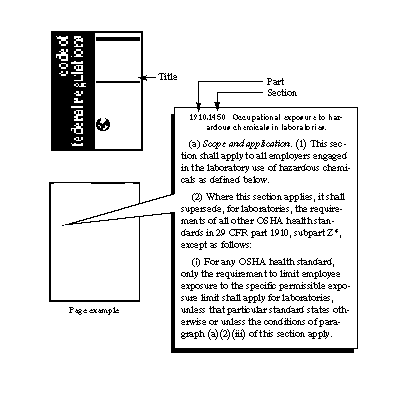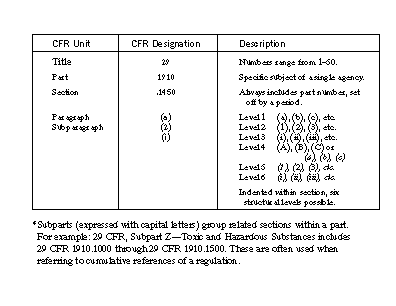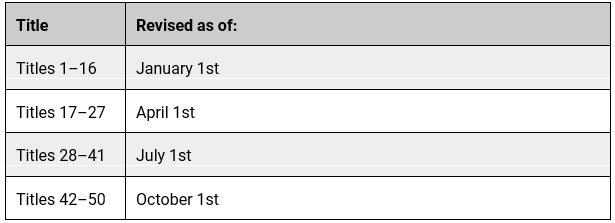Understanding the Code of Federal Regulations – Quick Tips
Introduction
Under Franklin D. Roosevelt’s New Deal in the 1930s, Congress began delegating more responsibility to federal agencies to create legislation. At the time, there was no centralized system to communicate up-to-date legislation from the executive department or the agencies of the federal government to the public. The Federal Register Act (1935) and the Administrative Procedure Act (1946) paved the way for the Federal Register System to issue and publish government laws.
Federal Register System
The Federal Register System’s two major publications are the Federal Register and the Code of Federal Regulations (CFR). The Federal Register is published and issued every federal working day. Legislation is published first as a proposed rule followed by a comment period. The comment period is a time the public can give their input on the proposed rule. Once the rule is finalized, it becomes a legal document a minimum of 30 days after publication in the Federal Register. These final rules are then codified and published annually in the CFR. The Federal Register and the CFR must be used together to determine an up-to-date stipulation of a ruling.

Code of Federal Registrations (CFR) Structure
Sometimes it requires a little research to obtain information from the CFRs. A typical OSHA reference may include the title, part, section, paragraph and sub-paragraph numbers. For example, 29 CFR 1910.1450(a)(2)(i), reads as Title 29, CFR, Part 1910, Section 1450, Paragraph (a), Subparagraph (2) (i). To help you better understand the organization of the CFRs, the following is an excerpt from 29 CFR 1910.1450:

Code of Federal Registrations Title Numbers and Descriptions
Each regulation falls under one of these 50 title numbers and subject areas:
- General Provisions
- Grants and Agreements
- The President
- Accounts
- Administrative Personnel
- Homeland Security
- Agriculture
- Aliens and Nationality
- Animals and Animal Products
- Energy
- Federal Elections
- Banks and Banking
- Business Credit and Assistance
- Aeronautics and Space
- Commerce and Foreign Trade
- Commercial Practices
- Commodity and Securities Exchanges
- Conservation of Power and Water Resources
- Customs Duties
- Employees’ Benefits
- Food and Drugs
- Foreign Relations
- Highways
- Housing and Urban Development
- Indians
- Internal Revenue
- Alcohol, Tobacco Products and Firearms
- Judicial Administration
- Labor—OSHA
- Mineral Resources
- Money and Finance: Treasury
- National Defense
- Navigation and Navigable Waters
- Education
- (Reserved)
- Parks, Forests, and Public Property
- Patents, Trademarks, and Copyrights
- Pensions, Bonuses and Veterans’ Relief
- Postal Service
- Protection of Environment—EPA
- Public Contracts and Property Management
- Public Health
- Public Lands: Interior
- Emergency Management and Assistance
- Public Welfare
- Shipping
- Telecommunication
- Federal Acquisition Regulations System
- Transportation—DOT
- Wildlife and Fisheries
For quick reference, the color of the book covers changes annually. The revision date indicates when the revision is begun, and the CFR may not be available to the public for approximately six months after the revision date. The titles are revised and published annually by the following schedule:

Index and Finding Aids
When researching by topic, the Index and Finding Aids found in the back of each CFR (and also published annually as a separate document) will be helpful. If you are trying to find up-to-date legislation or amendments on a regulation, you may need to consult the List of CFR Sections Affected (LSA), which is issued monthly by the Superintendent of Documents, U.S. Government Printing Office.
Commonly Asked Questions
Q: Can I publish material that includes CFR references?
A: Yes. The CFRs are public domain and no restrictions are placed on publication of the contents.
Q: Why are the reference numbers confusing?
A: The CFR format uses a period to separate the part number from the section number (instead of a decimal system), so “29 CFR 1910.2” would precede “29 CFR 1910.15.” Also, the many paragraph structural levels mix numerals and letters and include the use of lower case “a” proceeding capital “A” which is an unusual sequence.
Q: What are some examples of employees requiring hazmat training?
A: Employees who:
- Determine if a material is a hazardous material
- Design, produce and/or sell packaging for hazardous materials
- Determine proper packaging for hazardous materials
- Put hazardous materials into packaging
- Mark and/or label hazardous materials packages
- Fill out shipping papers for hazardous materials
- Load or unload hazardous materials
- Operate vehicles that transport hazardous materials
Sources
Superintendent of Documents
Mail OP: SSOP
Washington, DC 20402-9328
Government Printing Office: www.gpoaccess.gov
The Federal Register: What Is It and How To Use It, Office of the Federal Register, National Archives and Records Administration, June 1995.
Code of Federal Regulations, 29 CFR 1910–end, 1993.
GPO Access: Code of Federal Regulations
Electronic Code of Federal Regulations
The information contained in this article is intended for general information purposes only and is based on information available as of the initial date of publication. No representation is made that the information or references are complete or remain current. This article is not a substitute for review of current applicable government regulations, industry standards, or other standards specific to your business and/or activities and should not be construed as legal advice or opinion. Readers with specific questions should refer to the applicable standards or consult with an attorney.
Source: Grainger Know How – https://www.grainger.com/know-how